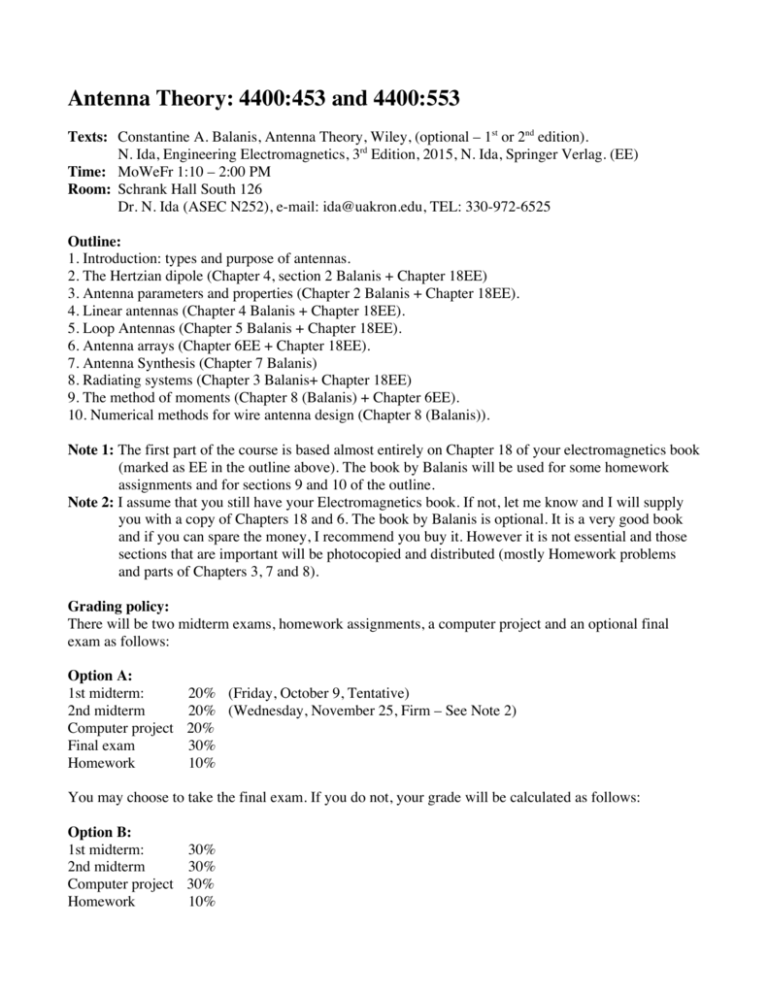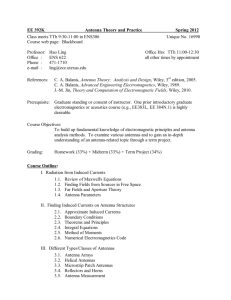Antenna Theory: 4400:453 and 4400:553
advertisement

Antenna Theory: 4400:453 and 4400:553 Texts: Constantine A. Balanis, Antenna Theory, Wiley, (optional – 1st or 2nd edition). N. Ida, Engineering Electromagnetics, 3rd Edition, 2015, N. Ida, Springer Verlag. (EE) Time: MoWeFr 1:10 – 2:00 PM Room: Schrank Hall South 126 Dr. N. Ida (ASEC N252), e-mail: ida@uakron.edu, TEL: 330-972-6525 Outline: 1. Introduction: types and purpose of antennas. 2. The Hertzian dipole (Chapter 4, section 2 Balanis + Chapter 18EE) 3. Antenna parameters and properties (Chapter 2 Balanis + Chapter 18EE). 4. Linear antennas (Chapter 4 Balanis + Chapter 18EE). 5. Loop Antennas (Chapter 5 Balanis + Chapter 18EE). 6. Antenna arrays (Chapter 6EE + Chapter 18EE). 7. Antenna Synthesis (Chapter 7 Balanis) 8. Radiating systems (Chapter 3 Balanis+ Chapter 18EE) 9. The method of moments (Chapter 8 (Balanis) + Chapter 6EE). 10. Numerical methods for wire antenna design (Chapter 8 (Balanis)). Note 1: The first part of the course is based almost entirely on Chapter 18 of your electromagnetics book (marked as EE in the outline above). The book by Balanis will be used for some homework assignments and for sections 9 and 10 of the outline. Note 2: I assume that you still have your Electromagnetics book. If not, let me know and I will supply you with a copy of Chapters 18 and 6. The book by Balanis is optional. It is a very good book and if you can spare the money, I recommend you buy it. However it is not essential and those sections that are important will be photocopied and distributed (mostly Homework problems and parts of Chapters 3, 7 and 8). Grading policy: There will be two midterm exams, homework assignments, a computer project and an optional final exam as follows: Option A: 1st midterm: 2nd midterm Computer project Final exam Homework 20% (Friday, October 9, Tentative) 20% (Wednesday, November 25, Firm – See Note 2) 20% 30% 10% You may choose to take the final exam. If you do not, your grade will be calculated as follows: Option B: 1st midterm: 2nd midterm Computer project Homework 30% 30% 30% 10% Notes: 1. The final exam will be given at the scheduled time. It is your choice to take it or not. If you do, your grade is calculated based on Option A. If you do not take the final exam, your grade is calculated based on Option B. There is no need to tell me of your choice but you are welcome to discuss it with me. Also, I will use the formula that gives you the best grade. Therefore, unless you are satisfied with the preliminary grade, you should take the final. The higher grade of the two options will be assigned. 2. I will be willing to move the second exam earlier but will not agree to have it after thanksgiving so that you may enjoy the thanksgiving break. 3. Before each exam, I will make available sample exams. These will be posted on my web site http://ee.ascs3.uakron.edu/ida/ under the heading Antenna Theory, for downloading. The number of exams may vary but usually there will be two exams with solutions and one without solutions. The purpose of this third exam is for you to try on your own. Homework: There will be 5-6 homework assignments during the Semester and a final “project”. Normally you will have two weeks to do the homework and about 1 month for the project. More will be said on the project during the semester. Office hours: Any time of day between 7:00 AM and 6:00 PM. Please feel free to see me anytime. There will be instances in which I will be busy with other activities. In such cases I ask that you either wait or see me at other times. Also, if you are not on campus, call me to ensure I am available. I also have set office hours on Monday Wednesday and Friday, 9-11 AM. I do have a class at 11:00 so please come early enough. Software: If you have not done so yet, I recommend you download the software “Electromagnetic Simulations” from my web page. The part on waves will be useful in understanding some issues on antennas. The software is written in Matlab. Details: In the following: EE – Enegineering Electromagnetics, Ida CB – Antenna Theory, Constantin Balanis MS – Numerical Techniques in Electromagnetics, Mathew Sadiku – I will provide the required material. Lecture 1: Introduction, EE Lecture 2: Electric and magnetic fields of the dipole – EE Lecture 3: Near and far fields of the dipole – EE Lecture 4: Radiated power density, power and radiation resistance – EE Lecture 5: Radiation patterns, radiation intensity – EE Lecture 6: Radiation intensity, directivity, maximum directivity, efficiency – EE Lecture 7: Gain, magnetic dipole (loop) – EE Lecture 8: Magnetic dipole, near and far fields, Table 18.1 – EE Lecture 9: Arbitrary long antenna – EE Lecture 10: Arbitrary long antenna – EE Lecture 11: λ/2 antenna, 3 λ /2 antenna, λ antenna – EE Lecture 12: Examples, monopoles, reflection antennas, intro to arrays – EE Lecture 13: Antenna arrays, 2 element array – EE Lecture 14: 2-element array – EE Lecture 15: 2-element array, n-element array – EE Lecture 16: n-element array – EE Lecture 17: n-element array, examples, reciprocity and receiving antennas – EE Lecture 18: Effective area, Friis formula – Pages EE Lecture 19: Friis formula, examples, intro to Radar – EE Lecture 20: Radar, examples, intro to numerical solution and MoM – EE, Lecture 21: Method of moments for electrostatics – EE – Chapter 6 Lecture 22: Method of moments – examples – EE, CB Pages 433 – 442 Lecture 23: Pocklington’s equation CB Pages 442 – 446 Lecture 24: Pocklington’s equation, Hallen’s equation CB Pages 443 – 447 Lecture 25: Hallen’s equation CB Pages 446 – 447, MS Pages 350 – 366 Lecture 26: Source modeling – Gap and frill generators CB Pages 447 – 451 Lecture 27: Source modeling – Frill generator CB Pages 447 – 451 Lecture 28: Method of Moments - CB Pages 450 – 458, MS Pages 350 – 366 Lecture 29: Antenna synthesis – Introduction CB Pages 385 – 388 Lecture 30: Schelkunoff method – CB Pages 385 – 392 Lecture 31: Fourier transform method – continuous – CB Pages 393 – 396 Lecture 32: Fourier transform method – linear arrays – CB Pages 396 – 399 Lecture 33: Woodward-Lawson method – Line source – CB Pages 399 – 404 Lecture 34: Woodward-Lawson method – Linear arrays – CB Pages 404 – 406 Lecture 35: Vector potentials – CB Pages 133 – 139 Lecture 36: Radiation integrals – CB Pages 139 – 146 Lecture 37: Aperture antenna – introduction – CB Pages 653 – 657 Lecture 38: Aperture antenna – Examples – CB Pages 657 – 660 Lecture 39: Radiation equations – CB Pages 660 – 663 Lecture 40: Radiation equations (cont.) – CB Pages 660 – 663 Lecture 41: Rectangular Apertures – CB Pages 663 – 665 Lecture 42: Rectangular Apertures – Uniform distribution – CB Pages 665 – 668 Lecture 43: Patch antennas – analysis – CB Pages 816 – 843 Lecture 44: Other antennas – Horns – CB Pages 883 – 893

![EEE 443 Antennas for Wireless Communications (3) [S]](http://s3.studylib.net/store/data/008888255_1-6e942a081653d05c33fa53deefb4441a-300x300.png)
